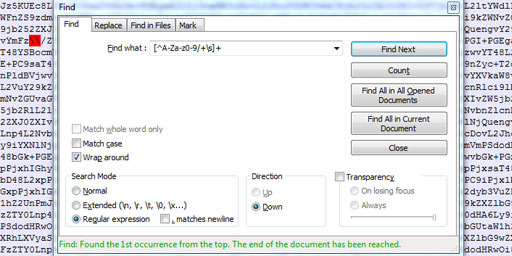HTML Base64
HTML is a standardized markup language for creating web documents which are usually interpreted by web browsers. As you probably already know, on a HTML page the web developer can embed and show external web resources, such as images, sound, or video files. Typically, for each web resource, the browser must make at least one HTTP request to load it. However, the web developer can directly “inject” the same web resources into the HTML page by encoding them to Base64 and embedding them with Data URI. This will avoid additional HTTP requests, which sometimes may significantly improve page speed. In addition, it can solve some “exclusive” tasks.
Below are listed the most popular HTML tags that support the Base64 Data URIs. Click on the desired HTML tag to get more information and see embedding examples.
 What is "aaaaigz0...my4xmda="?
What is "aaaaigz0...my4xmda="? Validate Base64 using Notepad++
Validate Base64 using Notepad++ Base64 encryption is a lie
Base64 encryption is a lie
Comments (28)
I hope you enjoy this discussion. In any case, I ask you to join it.
I am trying this :
<HTML style="margin:3em;background:rgb(2, 2, 51);color:rgb(87, 87, 201);font-family:Roboto;"><H1> It's an on the fly : Hellöchen ! </H1>
</HTML>
but in HTML base64 I am getting:
It's an on the fly : Hellöchen !This is a `Umlaute` problem.
Thnaks, Fried.
<meta charset="utf-8">
<p>Form<br>
<br>
Chart:<br>
<p><br>
<img src="data:image/png;base64,@{outputs('Executar_Script_Gráfico')?['body/result']}">
</p>
$2y$08$PpUxBDRKNucdAhqcOCX.xeUuWZF2Hh3OOUA.wG/sETK2JWISSdWnO
british porn stars on adultwork
what do you keep trying to achieve by sql injecting via comments?